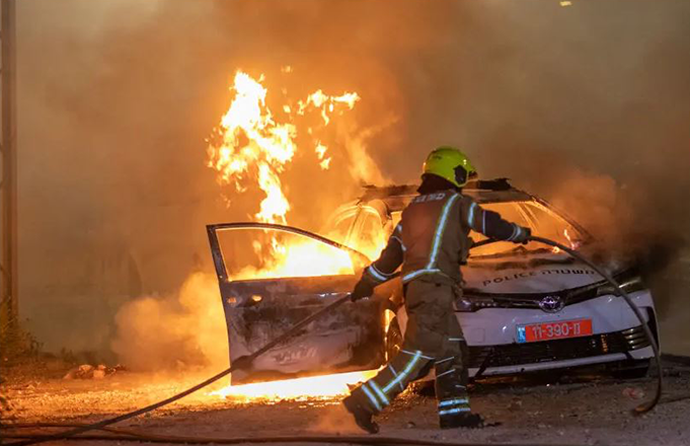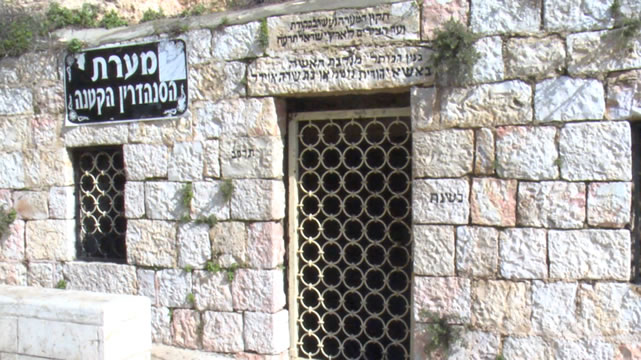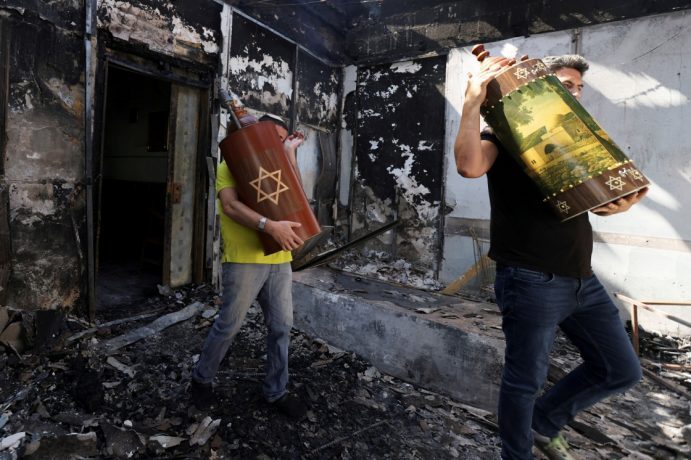Summary: The private (Jewish) owner of property brought eviction proceedings against Arab squatters and holdover tenants who failed to pay rent for decades. The current owner has a chain of title of voluntary purchases/sales that goes back to 1875, when two Jewish community trusts first bought the then-empty land. These ordinary eviction proceedings between private parties regarding 28 homes became a pretext to demonize Israel, perpetrate violent riots against Jews, and make bigoted demands that Israel override and ignore private property rights and discriminate against property owners simply because they are Jewish.
In 1875, Two Jewish Religious Trusts Purchased the Shimon HaTzadik Tomb and Surrounding Land: For centuries, Jews made pilgrimages to pray at the tomb of beloved 4th century BCE Kohen Gadol (high priest) Shimon HaTzadik (Simeon the Just), in Jerusalem, northeast of the Old City. In 1875, two Jewish trusts, the Sephardi Community Council and the (Ashkenazi) General Council of the Congregation of Israel (a.k.a the “General Committee of the Knesset of Israel”), purchased the tomb and nearby lands forming the “Shimon HaTzadik” and “Nahalat [Inheritance of] Shimon” neighborhoods. Palestine Chief Rabbi Avraham Ashkenazi and Jerusalem Chief Rabbi Meir Auerbach registered the property in the Ottoman land registry in 1875 and 1876. Dozens of poor Jewish families moved there and continued to live there.
In the late 1800s, wealthy Arabs (including the al-Husseinis) created a nearby neighborhood that the Arabs called “Sheikh Jarrah,” centered around the tomb of Hussam al-Din al-Jarrahi, a 12th century Muslim physician to Saladin.
The three neighborhoods existed side by side until 1948.
Pre-1948 Arab Attacks on Jewish Communities: Prior to 1948, Arabs periodically attacked and drove out Jews from Shimon HaTzadik and Nahalat Shimon, especially during the pogroms perpetrated by the Arabs in Jerusalem and throughout Mandatory Palestine in 1936-39. The Jews always returned to these neighborhoods, and continued to live there until 1948.
Vital Corridor to Mount Scopus; the 1948 Hadassah Medical Convoy Massacre: Shimon HaTzadik/Nahalat Shimon is a vital corridor to Mount Scopus, where Hadassah Hospital and Hebrew University are located. On April 13, 1948, during the first half of Israel’s War of Independence, Palestinian Arab military forces seeking to prevent the re-establishment of Israel attacked and murdered 78 Jewish doctors, nurses and others, primarily civilians—and a British soldier on their way to bringing medical supplies and personnel to Hadassah Hospital, as the medical supply convey passed through Shimon HaTzadik/Sheikh Jarrah.

Hadassah medical convoy ambulance attacked and destroyed in April 13,1948 Arab massacre of 78 Jewish doctors, nurses, and others while convoy passed through Shimon HaTzadik / Sheikh Jarrah
Jordan’s 1948 Invasion, Expulsion of Jews, 19-Year Illegal Occupation, and Sequestration and Rental of the Property: In May 1948, seven Arab nations invaded the newly reborn state of Israel. Jordan (then called Transjordan) attacked and illegally occupied large swaths of Jerusalem, including the Shimon HaTzadik and Nahalat Shimon neighborhoods. Jordan massacred or expelled all the Jews; denied Jewish property rights; illegally attempted to annex the land that Jordan illegally occupied; erased the Shimon HaTzadik and Nahalat Shimon neighborhoods; and re-assigned those neighborhoods’ lands to an expanded Sheikh Jarrah neighborhood. The “Jordanian Custodian of Enemy Property” sequestered all Jewish-owned property. In 1956, Jordan contracted with UNRWA to build houses, and leased the Shimon HaTzadik/Nachalat Shimon properties to 28 Arab families. The Jordanian Custodian of Enemy Property never transferred ownership to the Arab tenants.
1967 Israeli Liberation of Jerusalem; 1970 Israeli Law to Settle Property Rights; 1972 Jewish Owners’ Rights Re-Registered: Jordan’s attack on Israel during the 1967 Six Day War led to Israel recovering and reuniting Jerusalem. In 1970, the Israeli Knesset enacted the Legal and Administrative Arrangements Law to protect property rights in the wake of the reunification of Jerusalem. The most important provision in the law modified the definition of “absentee property” to protect the property rights of Palestinian Arab and Jordanian Arab owners in Jerusalem whose properties would otherwise have been considered sequestered from 1967.
Additionally, the law protected the new property rights that the Jordanian Custodian of Enemy Property had created by transferring most properties sequestered from Jewish owners to private Palestinian Arab owners or to the state or local governments. Thus, original private Jewish owners could not recoup their properties that Jordan had transferred to new private Arab owners during Jordan’s 19-year illegal occupation of eastern Jerusalem. In the small number of cases where the Jordanian Custodian had not transferred ownership of the sequestered Jewish property to new Arab owners, the law ordered the property’s release to the original owners.
The Jewish trusts that purchased the Shimon HaTzadik and Nachalat Shimon property in 1875 were in the small third category entitled to reclaim their lands. The Jewish trusts proved their ownership, won release of the sequestered property and reregistered their ownership in Israel’s land registry in 1972. They then tried to retake possession of their properties.
1972 – 49 Years of Litigation Begins; 1982 Settlement/Decision Reaffirms Jewish Ownership; Gives Arabs Protected Tenancies: The Jewish owners sued in 1972 in the Jerusalem Magistrate Court for the removal of three occupants. The Israeli Supreme Court decision affirmed the Jewish trusts’ ownership. In 1982, the Jewish trusts filed another suit to evict 17 non-paying Arab occupants. During the lawsuit hearing, the parties reached a settlement, which the court approved and has the status of a court decision, establishing agreed facts, including that the Jewish trusts are “the registered owner of the land,” and that the Arab occupants had acquired the status of leaseholders from the Jordanian Custodian of Enemy Property, and could invoke all the benefits of protected tenants status under Israel’s 1972 Tenant Protection Law.
The Jerusalem District Court and Supreme Court rejected the Arab tenants’ baseless claims that they were entitled to ownership because Jordan had promised to transfer the properties to them during Jordan’s illegal occupation of eastern Jerusalem. The tenants had no proof of this alleged promise, and acknowledged that the transfers never occurred. The tenants only submitted an unsigned, standard Jordanian housing ministry form, that did not bestow any ownership rights.
Arab Tenants Refuse to Pay Rent for Decades; Violate Their Protected Tenant Obligations; Trespass; Attempt to Nullify Court-Endorsed 1982 Agreement; Overstay After Leases End: Protected tenant status enables tenants and then their children (it expires after the second generation) to remain in the property as long as they pay rent, maintain the property and do not make renovations and additions without the owner’s consent. Arab tenants in Shimon HaTzadik/Nahalat Shimon violated all this: They refused to pay rent for decades.
Third generations who no longer had tenancy rights continued to stay in the properties. The Arab tenants built additions without permission and on adjacent lots to which they had no tenancy rights; violated court and municipal orders to cease this illegal construction; and then complained about demolition orders for their illegal construction.
The Arab tenants also repeatedly attempted to nullify the settlement that they agreed to in 1982. The Israeli courts repeatedly rejected the Arab tenants’ baseless, frivolous claims.
Arab Squatters with No Tenancy Rights: New Arab occupants – Arab squatters who had no tenancy rights – also entered the buildings and refused to pay rent.
Phony Third-Party Arab Ownership Claim Was Rejected By Multiple Courts: In 1997, someone with no connection to the property, Suliman Darwish Hajazi, filed a lawsuit in the Jerusalem District Court (TA 1465/97) claiming that he owned three quarters of the property. Hajazi alleged that in 1961, he purchased from a Jordanian man named al-Bandeq a kushan (Ottoman title) from 1897. (This was over two decades after the Jewish trusts purchased the land and registered their title in the Ottoman registry.) In March 2005, the Jerusalem District Court ruled that Hajazi’s alleged Kushan did not refer to the Shimon HaTzadik property; that Israel’s Forensic Police experts found that Hajazi’s kushan (especially the location) was altered or forged and that Hajazi’s 1961 sale agreement was not authentic; that Hajazi did not prove that al- Bandeq ever owned the property; and that Hajazi never exercised ownership rights; never charged rent; never entered into leases with the tenants; never paid property tax; never registered title in Jordan or Israel; “did not even turn to the Jordanian guardian in order to release the assets”; did nothing else to exercise his ownership for 30 years; and “did not prove that he had rights in the complex.”
Hajazi appealed to the Supreme Court, which re-examined Hajazi’s documents, and again concluded in a detailed, comprehensive judgment (on June 20, 2006 by Justice Rubinstein) that Hajazi did not own the land, and that his claim was never on any maps of the area. Hajazi then petitioned Israel’s High Court, which rejected his petition (HCJ 5839/05).
Despite the fact that the courts uniformly ruled that Hajazi did not own the property, tenant Riqva Kurd then claimed that Hajazi owned the property, as her defense, when the trusts sued Kurd for illegally constructing a structure on land adjacent to her apartment. In 2009, the Jerusalem Magistrate Decision rejected Kurd’s “defense,” and stated that the clear judgment, in three preceding courts, that Hajazi has no ownership rights “has long since become final.”
This is just one of many examples of how the Arab tenants, squatters, outsiders, and illegal builders on the Jewish trusts’ land raised and relitigated fraudulent, rejected claims.
Four other residents claimed they received title from an “Ismail” in 1991, but failed to otherwise identify “Ismail” or how he or they allegedly obtained title. Those residents were also not protected tenants.
U.S. courts would have sanctioned the Arab litigants’ lawyers for these frivolous claims.
2003: Israeli organization Nahalat Shimon Ltd. acquires rights in the property from the Jewish trusts, to initiate, in its name or on behalf of the Jewish Trusts, legal or administrative proceedings to evict intruders or tenants who were illegally on the land.
The Jewish Owners’ Rights and Eviction Claims Were Repeatedly Upheld by Israel’s Liberal Courts: The Jewish owners repeatedly won court decisions against the squatters and non-paying tenants who had expired leases, in litigation that has been prolonged for decades by the squatters’ and non-paying tenants’ frivolous appeals, and refusals to accept the legitimacy of Jewish ownership despite the Arabs’ own 1982 settlement agreement, and despite decades of litigation confirming and reconfirming the Jewish owners’ rights. However, only a few evictions actually took place, and much of the litigation is still ongoing, decades later.
Four Pending Eviction Final Appeals Are the Pretext for Recent Violence: In February 2021, in the Jaoni et al. v. Nahalat Shimon Ltd. case, the Jerusalem District Court, acting as a civil appeal court, upheld an October 2020 eviction order of the Jerusalem Magistrate Court, requiring 25 non-paying Arab residents (from 4 families) to vacate four of the properties. The District Court noted that the appellants included residents whose grandparents had signed the 1982 settlement acknowledging the Jewish owners’ ownership of the property, and residents with no protected tenancy rights (squatters) who had claimed without any proof that they purchased the property from the otherwise unidentified “Ismail.” The residents filed a (meritless) request for leave to appeal to the Israeli Supreme Court. Arab riots ensued to attempt to delay a final Supreme Court proceeding and decision, and to continue to deny the private Jewish owners their legal rights to possession of their property. This court proceeding between private parties was also used as a pretext to attack Jews throughout Israel and elsewhere. During Arab Krystallnacht-type riots in May 2021, Arabs murdered two Jews and wounded many others. According to Walla, an independent Israeli news site, Israeli Arab mobs wholly or partly burned down 10 synagogues; set fires in 112 Jewish homes and one Arab home mistaken for a Jewish home; plundered 386 Jewish homes; damaged 673 Jewish homes; set ablaze to 849 Jewish-owned cars; and engaged in 5,018 rock-throwing attacks on Jews.

Israeli police seen on the streets of the central Israeli city of Lod, where last night synagogues and cars were torched as well as shops damaged, by Arab residents rioting in the city, still ongoing this evening. May 12, 2021 (photo credit: YOSSI ALONI / FLASH90)
Prepared by ZOA attorneys Elizabeth Berney, Esq. (U.S.) and Dan Illouz, Adv. (Israel), Aug. 12, 2021.
ZOA also warmly thanks Professor Avi Bell, Esq. for his valuable review, input and improvements to this article.
Further Information:
“ZOA Israel Update: Understanding the Shimon HaTzadik Rental/Eviction Dispute,” featuring Univ. of San Diego School of Law & Bar Ilan Univ. Faculty of Law Professor Avi Bell, with introduction by ZOA National President Morton A. Klein, moderated by ZOA Israel representative Dan Illouz, July 2021 (video).
“Understanding the Sheikh Jarrah/Shimon Hatzadik Property Dispute,” by Professor Avi Bell, Jewish Press, May 13, 2021.
“What’s Really Going on with the Shimon HaTzadik Neighborhood,” (video), Jerusalem Heritage House, May 27, 2021.
“Primer on Sheikh Jarrah Property Claims,” NGO Monitor, May 3, 2021.
Jaoni et al. v. Nahalat Shimon Ltd., civil appeals decision of the Jerusalem District Court, by Judges Alexander Ron, Hagit Mack-Kalmanovich and Anat Singer, case 57595-11-20, Feb. 9, 2021, announced Feb. 27, 2021.
The Committee of the Sephardic Committee in Jerusalem and Nahalat Shimon Ltd. v. Riqva Kurd, decision of the Jerusalem Magistrate Court, by Justice Yitzhak Milnov, Mar. 4, 2009
“The U.S.-Israeli Dispute over Building in Jerusalem: The Sheikh Jarrah-Shimon HaTzadik Neighborhood,” by Nadav Shragai, Jerusalem Center for Public Affairs, July 27, 2009.
“Thousands Visit Shimon Hatzadik, Restore Jerusalem,” by Hezki Baruch, Israel Nat’l News, May 26 , 2016.
“Israel’s Critics are Right: ‘Sheikh Jarrah’ Exemplifies the Arab-Israeli Conflict: Shimon HaTzadik is a neighborhood where Jews and Arab could have lived side by side peacefully—had Arabs not tried to ethnically cleanse all of the Jews living there.,” by Micha Danzig, Jewish Journal, May 9, 2021.
“Sheikh Jarrah: A Legal Background,” by Arsen Ostrovsky, JNS, May 10, 2021. (Longer version.)
“District Courts Rule in Favor of Jewish Owners of 3 Homes in Eastern Jerusalem, Evict 87 Arab Squatters,” by David Israel, Jewish Press, Nov. 26, 1987. (Mentions that Palestinian Authority pressured Arab squatters in Silwan to reject generous offers to leave.)
“Sheikh Jarrah, Shimon Hatzadik: A Tale of Two Gravesites in Jerusalem,” by Jonathan Spyer, Jerusalem Post, May 12, 2021. (Parts are unclear; Also see corrective comments.)

